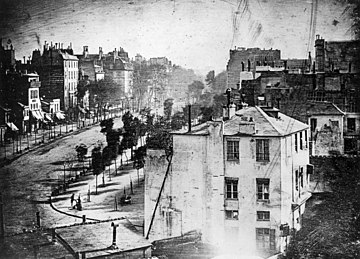Talk:Timeline of photography technology
| This article is rated List-class on Wikipedia's content assessment scale. It is of interest to the following WikiProjects: | ||||||||||||||||||||||||
| ||||||||||||||||||||||||
Permission[edit]
Copyright Permission to modify and distribute this and other timelines originally developed by Niel Brandt have been granted to wikipedia. See Talk:Timeline of transportation technology
The title of this article is grammatically incorrect, it should be 'Timeline of photographic technology'. Taking a pragmatic approach, it may not be worth the exercise of renaming, but everything in Wikipedia should be as correct as possible, so an error like this is unfortunate.
What do others think? - Chris Jefferies 11:31, 2 Jul 2004 (UTC)
Shouldn't the introduction of the new digital cameras be mentioned
in the timeline?
There was an article in "Scientific American" about the use of asphalt to make (very) crude pictures. This was postulated to be the first photograph.
Someone qualified (I'm not even a photographer) please check this and include if proper.24.10.102.46 04:56, 14 March 2006 (UTC)
Asphalt ? I think you are refering to what we call in French "bitume de Judée" ("bitume" is roughly équivalent to "asphalte" in French) that was used in Niepce's process. There is no need to update the timeline IMO. Ericd 17:37, 14 March 2006 (UTC)
external link[edit]
I have a page on my own website that deals with the history of digital photography (it starts with a brief history of photography itself, then links to the history of digital photography).
I would like to add it as a resource, but have been informed that I can't as it is my own site and Wikipedia rules don't allow this. Apparently someone else can take a look and add it if they feel it is worth it.
It's not a timeline, but more a commentary. I think it's an interesting read for someone who has already looked through this timeline page.
The url for my history page is: http://www.digital-photography-tips.net/history_of_digital_photography.html
I'd be obliged if someone would have a look through this page (and the links from it) and add it to the resources if they feel it is appropriate.
Thanks in advance,
Darrell.--Dazp1970 14:40, 9 September 2006 (UTC)
The caption on the second photograph is obviously wrong. It says "First photograph of a person, by Daguerre" but it depicts a street. A second issue that i´ve noticed to be controversial is the name of the invertor of the Collodion process. Most articles cite Frederick Scott Archer to be the inventor of it (including this article). I had always thought so, but the article on Collodion says it was Louis-Nicolas Ménard. It is also not clear when it was discovered, years ranging from 1848 to 1851. We would need to cite some sources here. Mrfoxtalbot
Practical technology only[edit]
This list is exclusively for the dates of introduction or demonstration of practical technology for photography. I have removed an entry that is a proposal for a space guidance system that included an optical sensor. There is no evidence that this system was ever built or that this proposal had any impact on later developments as it is never cited. Aldebaran66 (talk) 21:38, 18 September 2009 (UTC)
An expanded list[edit]
This page is being actively maintained and can be used if needed http://www.ausphotography.net.au/forum/showthread.php?19220-History-of-Photography-%28A-Timeline-of-significant-events%29 KymFarnik (talk) 23:02, 17 February 2013 (UTC)
File:Boulevard du Temple by Daguerre.jpg to appear as POTD[edit]
Hello! This is a note to let the editors of this article know that File:Boulevard du Temple by Daguerre.jpg will be appearing as picture of the day on May 4, 2015. You can view and edit the POTD blurb at Template:POTD/2015-05-04. If this article needs any attention or maintenance, it would be preferable if that could be done before its appearance on the Main Page. Thanks! — Crisco 1492 (talk) 00:03, 14 April 2015 (UTC)
4 Million ISO Camera?[edit]
Canon released a 4 million iso camera this year (2015). http://www.usa.canon.com/cusa/about_canon/newsroom?pageKeyCode=pressreldetail&docId=0901e02480fb7db6 Thought it seems like a technological milestone, worthy of this page, what does everyone think? Concheria (talk) 23:02, 23 August 2015 (UTC)





